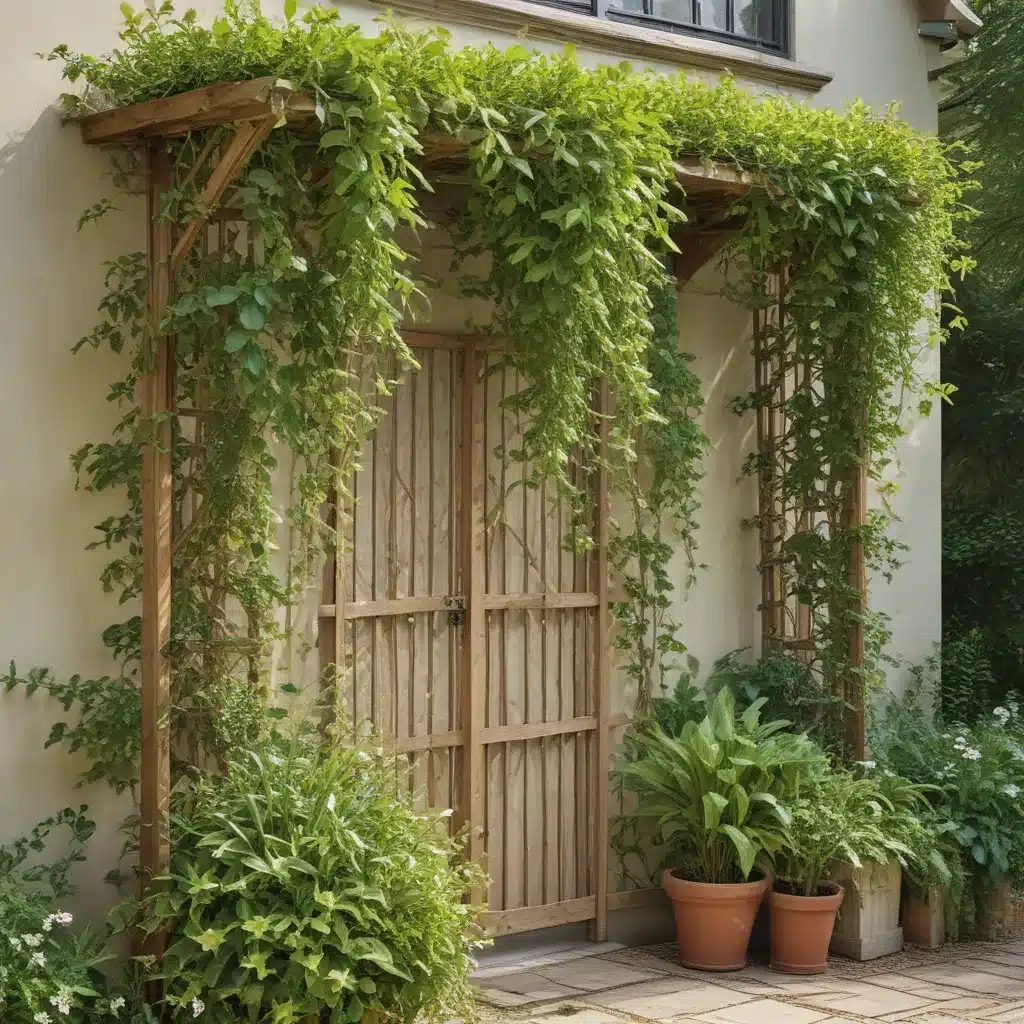
Bringing Charm and Productivity to Your Garden
Have you ever walked through a garden and felt the magic of vines and flowers cascading down from above? It’s a sight that just captivates the senses, isn’t it? Well, let me share a little secret – you can create that same sense of wonder and whimsy in your own backyard by going vertical with trellises and climbing plants.
I’ll be honest, when I first started tinkering with the idea of growing edibles up on trellises, I was a bit skeptical. How could those delicate vines possibly support the weight of melons or squash? But let me tell you, with the right setup, you can unlock a whole new world of space-saving, easy-to-harvest, and downright beautiful vertical gardening.
Expanding Your Garden Footprint
One of the biggest advantages of growing on trellises is that it allows you to maximize your available garden space. Think about it – a single watermelon plant can sprawl out to cover 20 square feet on the ground. But when you train that same plant up a 4-foot wide trellis, you’ve just condensed its footprint down to a mere 4 square feet! That’s an incredible space-saving hack.
As the experts at Roots & Refuge explain, arched trellises not only create stunning visual appeal, but they also make gardening more successful and easier on the gardener. No more searching through a tangled mess of vines to find your cucumbers or squash. Just stroll up to your trellis and voila – there they are, hanging in neat rows for the taking.
Choosing the Right Plants
Of course, not every plant is going to thrive when you put it on a trellis. The key is to select varieties that are natural climbers. Cucumbers, melons, peas, and beans are all excellent candidates that will happily scale up a vertical support system.
I’ve had great success with growing personal-sized melons like cantaloupe and honeydew on trellises. As the experts at Abundant Mini Gardens advise, you’ll want to plant two melon plants per 4-foot wide trellis, spacing them about a foot in from the edges. This gives the roots plenty of room to spread out while still allowing the vines to grow up and over the structure.
And don’t forget about the visual appeal of trailing vines! Clematis, Dutchman’s pipe, and passion flowers will all put on an eye-catching display as they drape themselves gracefully over your trellis.
Building a Sturdy Support System
Of course, no vertical garden is complete without a sturdy trellis to hold everything up. While you can certainly buy pre-made options, I find that it’s often more cost-effective (and fun!) to build your own custom setup.
My personal favorite is to use 4-foot wide livestock panels. These heavy-duty wire grids are incredibly strong, yet still lightweight enough to be easily manipulated. I simply cut the panels in half, attach them to a few t-posts, and voila – an instant 4×7-foot trellis that can handle just about anything I throw at it.
As the team at Riley’s Garden points out, you can also build a simple trellis frame out of wood and then train your plants up it. This works great if you’re growing in raised beds and don’t want to risk damaging the roots by driving in stakes.
Whichever route you choose, just make sure your trellis is tall enough (at least 6 feet) and sturdy enough to support the weight of your climbing plants as they mature. You don’t want your melons or squash crashing down halfway through the season!
Providing Gentle Guidance
Even with a solid trellis in place, some plants may still need a little extra help finding their way up. That’s where a bit of gentle training and support comes in handy.
I like to use soft, flexible materials like pantyhose, garden twine, or even old cotton shoelaces to gently guide my vines upwards. Just wrap a loop around the stem and secure it to the trellis. As the plant grows, you can continue to retie and reposition the vines to keep them climbing skyward.
One clever gardener on Reddit even used 100% compostable cotton twine to create a vertical trellis – talk about sustainability!
The key is to avoid using anything too rigid or abrasive, as that can end up damaging the delicate plant tissues. And don’t be afraid to gently reposition wayward vines as needed. With a little TLC, those climbing plants will soon be soaring up your trellis.
Reaping the Rewards
So, why should you consider going vertical in your garden? Well, the benefits are plentiful!
For starters, trellis-grown plants are much easier to maintain and harvest. No more bending and stooping to hunt through sprawling vines. Just stroll up to your vertical garden and pluck those juicy melons or crisp cucumbers right off the plant.
ABC Home & Garden also reports that vertical gardening can help deter pests and diseases. By lifting your plants off the ground, you reduce the risk of soil-borne issues like powdery mildew or bacterial wilt. And those hanging fruits and veggies are much harder for ground-dwelling critters to access.
But perhaps the most rewarding aspect of vertical gardening is the sheer visual impact. Imagine walking through your garden and being surrounded by lush, cascading vines laden with colorful produce. It’s like stepping into a secret oasis, complete with that sense of magic and wonder that only a well-designed vertical garden can provide.
So, what are you waiting for? Grab some trellises, select your favorite climbing plants, and get ready to transform your garden into a true vertical wonderland. Your harvest (and your Instagram followers) will thank you!
















